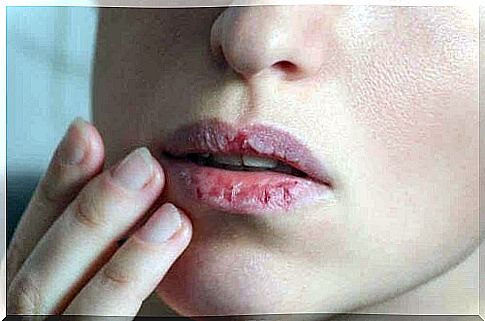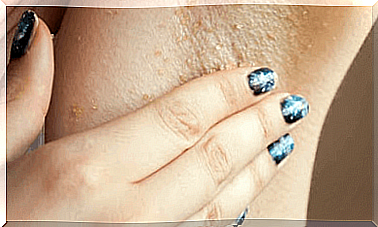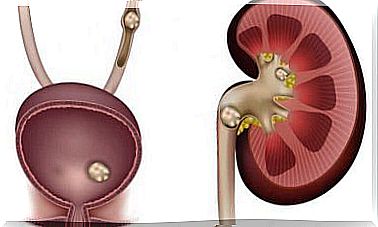Lip Color Changes As A Symptom

Color changes in the lip, skin and mucous membranes indicate problems, as these are the most important defense barrier in the human body. In general, they express the state of inner health. However, there may be times when they may indicate the presence of a condition, deficiency or disease. Keep reading to find out more about what color changes in the lips mean!
The lips are one of the most sensitive and delicate tissues and have over a million nerve receptors. Their color is due to the presence of many blood vessels that run below the surface. The amount of melatonin that determines pigmentation also plays a role.
Usually a healthy look ranges from a light pink to a brownish hue. However, some changes in lip color may indicate that something is not right. These variations range from partial spots to blue or purple, whitish and black colors.
Causes of changes in lip color
The skin on the lips is often exposed to external factors that change the composition and physiology. Smoking is an example of this. In turn, many diseases manifest as lesions or changes. Some studies claim that the appearance of soft tissue on the face reflects the condition of the underlying hard tissue.
Color changes in the lips can be due to a long list of conditions such as dehydration, malnutrition and exposure to sunlight. However, they are also often a clinical manifestation of cardiovascular, respiratory, oncological and hematological pathologies.
White lips
The manifestation of white or pale lips is usually due to dehydration and a reduction in the number of red blood cells in the blood or anemia. This sign is usually an obvious pallor that includes the conjunctiva, gums and under the nails.
Estimates indicate that diarrhea is the most common cause of dehydration, especially in children and adolescents. In addition, fluid loss may be correlated with internal or external bleeding – such as heavy menstruation.
In most patients, anemia is usually the result of nutritional deficiencies. This is the case with low intake or absorption of iron, vitamin B12 and folic acid. In addition, some inherited diseases such as thalassemia or haemophilia can cause it.

Blue lips
Bluish lips, skin and other mucous membranes are clinically diagnosed as cyanosis. The red color of the blood is a result of the concentration of hemoglobin in the blood. However, it turns dark or purple at a low oxygen level, which determines the manifestation of cyanosis, according to studies.
The presence of blue lips, fingers and mucous membranes is usually a result of respiratory and cardiovascular conditions. Chronic obstructive pulmonary disease (COPD), asthma, mechanical asphyxia and respiratory failure are also common here.
In addition, heart failure, shock, sepsis, low temperatures and pesticide poisoning can cause this condition. In addition, some congenital disorders, such as ventricular septal defects and vascular malformations, are associated with blue lips.
Black lips
Blackish lip staining is usually caused by lesions in the oral mucosa or processes that promote melanin production. Hyperpigmentation of the lips and skin is common in Addison’s disease. The main characteristic is a lack of production of cortisol and aldosterone.
Studies also estimate that the continuous consumption of tobacco and cigarettes affects the dark pigmentation of the labial, gingival and periodontal mucosa. In addition, bruises from injuries and burns can give a black or purple color to the lips.
Lip patches
The presence of spots with variable diameter and shape on the lips can be due to a long list of reasons. Pigmentation of ultraviolet rays from the sun is the most common cause.
They usually manifest themselves in shades ranging from beige to dark brown. Lip color changes due to blemishes can also manifest themselves in the following cases:
- Hemochromatosis
- Laugier-Hunziker disease
- Peutz-Jegher’s disease
- Oral neoplasms
- Antipsychotic drugs, such as chlorpromazine
Diagnosis and treatment of various lip color changes
This type of diagnosis is based on a comprehensive physical examination by the doctor. Similarly, they should consider the presence of other associated clinical manifestations, such as variations in skin tone in other parts of the body.
The presence of cardiovascular or respiratory signs and symptoms is useful for diagnostic guidance. In addition , the doctor must consider the patient’s habits, as well as family history and any previous illnesses. Biopsies can in some cases be useful in suspected neoplasms.
The treatment usually aims to treat the underlying disease that causes discoloration of the lips. For this, the specialist can use hydration, nutrient replacement and oxygen administration.
In addition, laser, intense pulsed light, cryotherapy and phototherapy are used to treat hyperpigmented pathologies that cause changes in lip color. Furthermore, a doctor may prescribe some topical medications as part of the treatment.

Lifestyle and prevention
The skin on the lips is delicate and you need to take care of them continuously. Therefore, use moisturizing cream and sunscreen and also reduce direct exposure to sunlight.
A balanced diet that contains all vitamins and minerals also helps reduce the risk of anemia and changes in lip color. In addition, you need to drink enough water to ensure proper hydration.
Quitting smoking leads to an improvement in oral, respiratory and cardiovascular health. So you can start by setting goals and establishing a cessation plan by consulting a specialist.
When should you see a doctor if you notice changes in lip color?
Early identification of lip color changes improves the prognosis for most patients. In this connection, consult a doctor if you notice an increase or decrease in color, especially if it manifests itself with other symptoms.
Seek emergency medical attention if there are signs of bluish or cyanotic color associated with shortness of breath. This is because some treatments for severe pathology are time sensitive to prevent possible complications.









